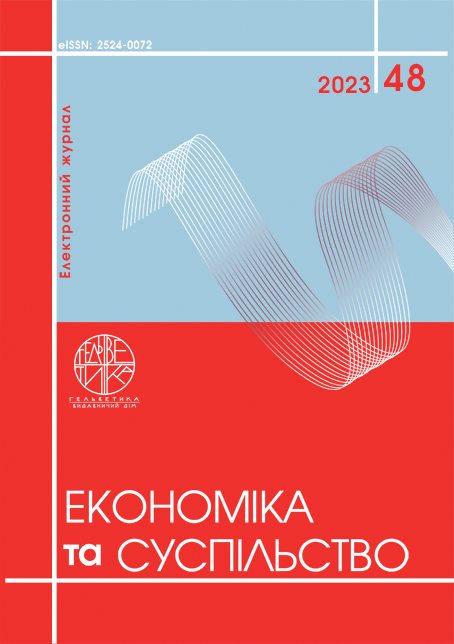DETECTION OF FRAUD IN THE COMPANY: ALGORITHM OF ACTIONS AND SIGNS THAT INDICATE A SIGNIFICANT RISK OF THE PRESENCE OF FRAUDULENT ACTIONS
Abstract
The article examines indicators that indicate a significant risk of financial fraud on a company, taking into account its institutional peculiarities and the state of its activities, macro and global environment. The following can be attributed to the indicators that indicate the threat of fraudulent activities on the company based on its institutional peculiarities and the state of its activities: organizational and legal structure and form of ownership of the enterprise, place of registration and separate subdivisions, the state of the company's activities. The article also identifies indicators based on macro and global environment conditions, including economic, legislative and regulatory, scientific and technical, natural, social and demographic indicators. The article proposes a list of questions that, once explored, will enable the audience to determine the level of risk of fraudulence concerning the management personnel and owners, employees of various departments of the enterprise, and counterparties. Additionally, the article offers a methodology for evaluating the overall risk of financial fraudulence in the enterprise. In particular, the revised ISA 315 standard now requires the quantitative evaluation of audit risk, and our developed methodology will enable auditors to effectively fulfill this requirement. The methodology for evaluating the overall risk of financial fraudulence in the enterprise is based on the analysis of various factors, including institutional peculiarities of the enterprise, its operational status, macro and global environment, and internal factors, such as the level of effectiveness of internal control and risk management. The risk assessment is conducted by analyzing specific indicators and signs that point to the possibility of fraudulence. The results of the evaluation enable the establishment of the overall risk level and the implementation of measures to reduce its impact on the enterprise. The article also developed an algorithm for assessing the level of fraud risk and detecting fraudulent activities. To simplify the selection of audit procedures, the algorithm for identifying fraud risks in the enterprise includes testing based on questions and takes into account macro and global environmental factors as well as institutional peculiarities of the enterprise.
References
Каменська Т. Шахрайства при аудиторській перевірці. Бухгалтерський облік і аудит. 2015. № 6. С. 2–7.
Климко Т.Ю., Мельник О.О. Корпоративне шахрайство: реалії сучасності. Науковий вісник Ужгородського університету. Серія: Економіка. 2015. Вип. 2. С. 185–190. URL: http://nbuv.gov.ua/UJRN/Nvuuec_2015_2_33 (дата звернення: 22.01.2023).
Хамига Ю.Я. Фінансове шахрайство: критерії ідентифікації та напрями мінімізації. Дисертація на здобуття наукового ступеня доктора філософії за спеціальністю 072 «Фінанси, банківська справа та страхування», 2020. 308 с.
Кізима Т., Хамига Ю. Фінансове шахрайство: теоретична концептуалізація та економічне підґрунтя. Світ фінансів. 2019. Вип. 2 (59). С. 109–123.
Бура О.В., Добровольська І.І. Фінансове шахрайство в Україні та заходи протидії. URL: http://libfor.com/index.php?newsid=2879 (дата звернення: 12.10.2022).
Возняк Г.В. Фінансове шахрайство в бюджетній сфері: економічна сутність і різновиди. Бізнес Інформ. 2020. № 4 (507).
Клапків Ю. Аналіз соціально-економічних мотивів участі в фінансових пірамідах. Страхова справа. 2016. № 4 (64).
Клапків Ю. Конфлікт інтересів у діяльності страхових посередників. Науковий вісник Мукачівського державного університету. Серія «Економіка». 2017. Вип. 2 (8).
Шевцов, В. М. Корпоративне шахрайство в українських компаніях. Довідник економіста. 2019. Вип. 6. С. 64–68. URL: https://sk.ua/wp-content/uploads/2019/06/%D0%A8%D0%B5%D0%B2%D1%86%D0%BE%D0%B2.pdf (дата звернення: 13.10.2022).
PwC. Global Economic Crime and Fraud Survey 2020. URL: https://www.pwc.com/ua/uk/survey/2020/gecs-ua-2020-ukr.pdf (дата звернення: 11.10.2022).
Association of Certified Fraud Examiners. Report to the Nations: 2022 Global Study on Occupational Fraud and Abuse. 2022. URL: https://legacy.acfe.com/report-to-the-nations/2022/ (дата звернення: 03.10.2022).
Association of Certified Fraud Examiners. Report to the Nations: 2020 Global Study on Occupational Fraud and Abuse. 2020. URL: https://acfepublic.s3-us-west-2.amazonaws.com/2020-Report-to-the-Nations.pdf (дата звернення: 10.09.2022).
Kamenska T. (2015). Shakhraistva pry audytorskii perevirtsi. [Audit fraud]. Bukhhalterskyi oblik i audyt (6nd ed., pp. 2–7) [in Ukrainian].
Klymko T. Yu., Melnyk O. O. (2015). Korporatyvne shakhraistvo: realii suchasnosti. [Corporate fraud: modern realities]. Naukovyi visnyk Uzhhorodskoho universytetu ‒ Scientific Bulletin of Uzhhorod University Seriia: Ekonomika (2nd ed., pp. 185-190). Retrieved from http://nbuv.gov.ua/UJRN/Nvuuec_2015_2_33 [in Ukrainian].
Khamyha Yu. Ya. (2020). Finansove shakhraistvo: kryterii identyfikatsii ta napriamy minimizatsii. [Financial fraud: identification criteria and directions for minimization]. Dysertatsiia na zdobuttia naukovoho stupenia doktora filosofii za spetsialnistiu 072 «Finansy, bankivska sprava ta strakhuvannia» (308 p) [in Ukrainian].
Kizyma T., Khamyha Yu. (2019). Finansove shakhraistvo: teoretychna kontseptualizatsiia ta ekonomichne pidgruntia. [Financial fraud: theoretical conceptualization and economic background]. Svit finansiv ‒ The world of finance (2nd ed., pp. 109–123) [in Ukrainian].
Bura O. V., Dobrovolska I. I. Finansove shakhraistvo v Ukraini ta zakhody protydii. [Financial fraud in Ukraine and countermeasures]. Retrieved from http://libfor.com/index.php?newsid=2879 [in Ukrainian].
Vozniak H.V. (2020). Finansove shakhraistvo v biudzhetnii sferi: ekonomichna sutnist i riznovydy. [Financial fraud in the budget sphere: economic essence and varieties]. Biznes Inform (4nd ed., 507 p.) [in Ukrainian].
Klapkiv Yu. (2016). Analiz sotsialno-ekonomichnykh motyviv uchasti v finansovykh piramidakh. [Analysis of socio-economic motives for participation in financial pyramids]. Strakhova sprava ‒ Insurance case (4nd ed., 64 p.) [in Ukrainian].
Klapkiv Yu. (2017). Konflikt interesiv u diialnosti strakhovykh poserednykiv. [Analysis of socio-economic motives for participation in financial pyramids]. Naukovyi visnyk Mukachivskoho derzhavnoho universytetu ‒ Scientific Bulletin of Mukachevo State University. Seriia «Ekonomika» (2nd ed.) [in Ukrainian].
Shevtsov, V. M. (2019). Korporatyvne shakhraistvo v ukrainskykh kompaniiakh. [Corporate fraud in Ukrainian companies]. Dovidnyk ekonomista ‒ Handbook of the economist (6nd ed., pp. 64-68). Retrieved from https://sk.ua/wp-content/uploads/2019/06/%D0%A8%D0%B5%D0%B2%D1%86%D0%BE%D0%B2.pdf [in Ukrainian].
PwC. Global Economic Crime and Fraud Survey 2020. Retrieved from https://www.pwc.com/ua/uk/survey/2020/gecs-ua-2020-ukr.pdf
Association of Certified Fraud Examiners. Report to the Nations: 2022 Global Study on Occupational Fraud and Abuse. 2022. Retrieved from https://legacy.acfe.com/report-to-the-nations/2022/
Association of Certified Fraud Examiners. Report to the Nations: 2020 Global Study on Occupational Fraud and Abuse. 2020. Retrieved from https://acfepublic.s3-us-west-2.amazonaws.com/2020-Report-to-the-Nations.pdf


